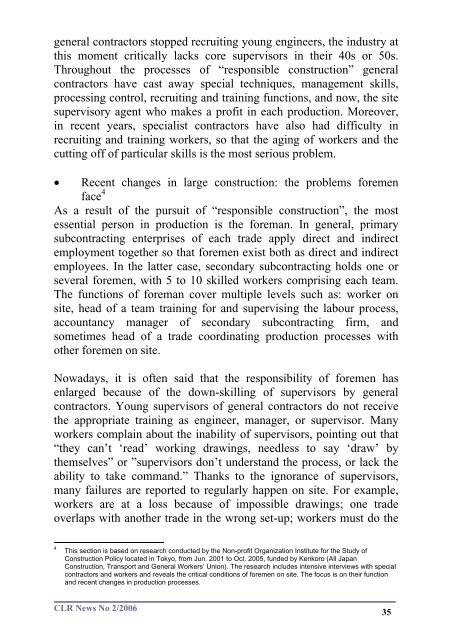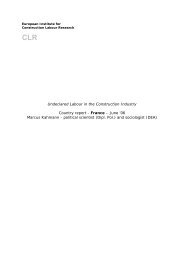Japan – what can we learn? - Construction Labour Research
Japan – what can we learn? - Construction Labour Research
Japan – what can we learn? - Construction Labour Research
You also want an ePaper? Increase the reach of your titles
YUMPU automatically turns print PDFs into web optimized ePapers that Google loves.
general contractors stopped recruiting young engineers, the industry atthis moment critically lacks core supervisors in their 40s or 50s.Throughout the processes of “responsible construction” generalcontractors have cast away special techniques, management skills,processing control, recruiting and training functions, and now, the sitesupervisory agent who makes a profit in each production. Moreover,in recent years, specialist contractors have also had difficulty inrecruiting and training workers, so that the aging of workers and thecutting off of particular skills is the most serious problem.• Recent changes in large construction: the problems foremenface 4As a result of the pursuit of “responsible construction”, the mostessential person in production is the foreman. In general, primarysubcontracting enterprises of each trade apply direct and indirectemployment together so that foremen exist both as direct and indirectemployees. In the latter case, secondary subcontracting holds one orseveral foremen, with 5 to 10 skilled workers comprising each team.The functions of foreman cover multiple levels such as: worker onsite, head of a team training for and supervising the labour process,accountancy manager of secondary subcontracting firm, andsometimes head of a trade coordinating production processes withother foremen on site.Nowadays, it is often said that the responsibility of foremen hasenlarged because of the down-skilling of supervisors by generalcontractors. Young supervisors of general contractors do not receivethe appropriate training as engineer, manager, or supervisor. Manyworkers complain about the inability of supervisors, pointing out that“they <strong>can</strong>’t ‘read’ working drawings, needless to say ‘draw’ bythemselves” or ”supervisors don’t understand the process, or lack theability to take command.” Thanks to the ignorance of supervisors,many failures are reported to regularly happen on site. For example,workers are at a loss because of impossible drawings; one tradeoverlaps with another trade in the wrong set-up; workers must do the4This section is based on research conducted by the Non-profit Organization Institute for the Study of<strong>Construction</strong> Policy located in Tokyo, from Jun. 2001 to Oct. 2005, funded by Kenkoro (All <strong>Japan</strong><strong>Construction</strong>, Transport and General Workers’ Union). The research includes intensive interviews with specialcontractors and workers and reveals the critical conditions of foremen on site. The focus is on their functionand recent changes in production processes.CLR News No 2/200635









